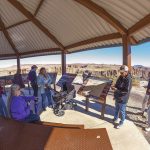
Contaminated water on its way to Navajo

Contaminated wastewater snakes its way down the Animas River on Aug. 6, 2015. (Photo courtesy KOB-TV - Channel 4 and Las Platas County Sheriff's Office.)
By Alastair Bitsoi and Terry Bowman
Navajo Times
WINDOW ROCK
One million gallons of mine wastewater that breached a wall at the Gold King Mine near Silverton, Colo., is making its way to the Navajo Nation.
The spill of heavy metals – lead, arsenic, cadmium, aluminum and copper – will likely impact downstream users, including over 10 Navajo chapters and hundreds of farmers that rely on the San Juan River.
As of 3 p.m. Friday afternoon, the yellow, murky plume had moved into New Mexico from the Animas River, whose headwaters begin in Colorado.
The waste in the Animas River was trigged after officials from the U.S. Environmental Protection Agency used heavy machinery to check for pollutants at the abandoned Gold King Mine. The EPA has taken the blame for the spill, which was caused from EPA officials removing backfill from the mine to access it and accidently released the waste. According to the EPA, the pollutants are not harmful to humans.
The estimated one million gallons of waste was released into Cement Creek on Wednesday, a tributary of the Animas River. The Animas River flows into the San Juan River in New Mexico and then joins the Colorado River in Utah.
According to Shiprock Chapter President Duane Chili Yazzie, the spill is expected to arrive in Shiprock by this evening or so, having passed through several Navajo communities including Upper Fruitland, Nenanazad and Tse Dikaan.
Other Navajo communities that will likely be impacted are Gadiihi, just west of Shiprock, as well as Aneth and Montezuma Creek, before going into Lake Powell.
“We shut off our irrigation system, so none of that contaminated water will go into our farm areas,” Yazzie told the Times via telephone Friday.
In Shiprock, there are about 500 farmers that would be directly impacted, Yazzie said, adding the biggest concern is not knowing when to open up the system to allow water to flow and what kind of contamination will persist.
“That would be devastating to many families,” Yazzie added, explaining that he has not heard of any reports of the concentration of contaminants that would pass through Shiprock.
“I don’t know how much will stay in the water or stick to the shore line,” he added.
Yazzie went on to say that there are a handful of residents that live near the banks of the San Juan River. “There is not much you can do,” he said, “We’ll just wait it out.”
Culturally, Navajos revere water for it bringing life, a critical element in tribal ceremonies. Some Navajo medicine healers conduct offerings to the San Juan River, considered a male body of water in Navajo culture.
As a result of the spill, Navajo Nation President Russell, Navajo Nation Vice President Jonathan Nez, and Speaker LoRenzo Bates have issue statements regarding their concerns of the waste spill.
Begaye, according to a news release from his office, demands the U.S. EPA to release information on the contaminants, referring to the spill an environmental catastrophe.
“We are demanding from the U.S. EPA an immediate release of detailed information on the type of contaminants that is flowing into the river from the Gold King Mine,” Begaye said.
According to a U.S. EPA press release, the contaminants include lead, arsenic, cadmium, aluminum and copper.
He went on to say that the spill is another familiar story of the U.S. government’s lax oversight responsibility.
“It is unfortunate that we have to once again tell our people to stay away from the river, due to the release of dangerous chemicals into our water,” Begaye said.
Begaye has put several tribal programs, including Navajo Nation EPA, Department of Health and Public Health Emergency Preparedness Program, on standby.
Nez added that he’s concerned with the farmers along the San Juan River.
“The contamination will probably hit Lake Powell soon,” he said, adding that the community of Mexican Hat, which pumps drinking water from the river, proceeds with caution.
“We need to monitor the water to ensure it is potable,” Nez said.
Meanwhile, Bates has been in contact with several Navajo chapters along the San Juan River. He said, according to U.S. EPA, that the contamination does not pose detrimental threats.
“I strongly urge nearby chapters and our people who reside near the San Juan River to refrain from using the water for any purposes until a thorough evaluation is completed,” Bates said.
The speaker also mentioned how the Navajo Agricultural Products Industry and officials there have stated how the spill will not adversely impact the Navajo Indian Irrigation Project water delivery to the large-scale farm.
NIIP diverts water directly out of the Navajo Reservoir, which does not receive any water fro the Animas River, Bates said.
“The Office of the Speaker remains engaged and updates as the situation evolves,” Bates said, adding that his office has been in contact with tribal, county and state officials to track the ongoing contamination.
To read the full article, pick up your copy of the Navajo Times at your nearest newsstand Thursday mornings!
Are you a digital subscriber? Read the most recent three weeks of stories by logging in to your online account.








 Highway 264,
Highway 264, I-40, WB @ Winslow
I-40, WB @ Winslow